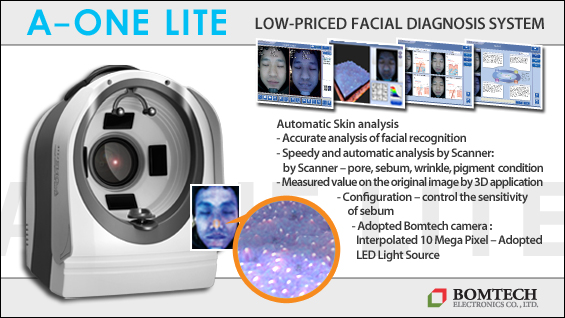▶ Previous Artlcle : #2-1. Minimally Invasive Anti-aging Procedures
Accu-lift, Micro fat transfer
This lift procedure is performed using 1444nm wavelength Accusculpt lipolytic laser. Based on the principle of selective photothermal damage from laser generated by less than 1mm thick optic fibers, this procedure delivers heat to the dermis in the desired direction to induce tightening and lifting effect. Especially, if used on fatty, aged tissues such as sagging cheeks, nasolabial folds and chin, combined effects of fat reduction and lifting can be achieved. Parameters should be set carefully not to deliver excessive heat and tumescent local anesthesia is carried out.
[Advertisement] A-One LITE(Facial Diagnosys System) – Manufacturer: BOMTECH(www.bomtech.net)
In the lower eyelid fat bulging as a aging process, Accu-lift can be used to dissolve, micronize and transfer fatty tissues to correct the depressed area under the fat bulging. A small puncture is created using a needle at junction of the medial canthus and under-eye wrinkle. The Accusculpt laser fibers are inserted through the puncture to emulsify the fat under the eyes, then the arcuate ligament (orbitomalar ligament) is separated. The micronized fat is pressed and moved with a finger to the sunken area and the dermis is tightened by heat. This procedure can be applied to the nasolabial folds and wrinkles around the mouth (Figure 1, before and after micro fat transfer of lower eyelid fat bulging).

Figure 1. before and after micro fat transfer of lower eyelid fat bulging.
Chemical peeling
Chemical peeling entails a long downtime following the procedure but is considered as a comprehensive solution to various signs of aging due to its excellent effect. Phenol is mainly used as the deep peeling agent, however, problems related to authorization and side effects limit its application and require caution. When used in high concentrations, local or partial peeling is advised. Light chemical peeling with salicylic acid or Jessner solution can be used without serious complication.
Surgical facelift, MACS lift
This procedure can be applied to the most severe form of facial skin aging; drooping cheeks without elasticity, and fatty tissues collecting around the nasolabial folds or mouth. Surgical facelift, mini or MACS (Minimal Access Cranial Suspension) face lift are suitable in elderly patients in their 60s to 70s who do not expect improvement from the above mentioned procedures.
The drooping skin of the upper face area can be lifted through cranial incision or endoscopic surgery. Patients often complain of mid to lower face sagging. Various ligaments that work between the skin and bone are distended causing deepening of the marionette lines and a dent under the zygomatic arch. The incision is made along the hairline and periauricular areas of the temporal head. The excess skin is resected and the fascia is elevated.
MACS lift uses purse string sutures, and may lead to nerve damage and masking face if performed aggressively, and therefore should be cautious. In case of sagging jawlines, the platysma muscle is also elevated with the procedure. To remove the nasojugal fat, Acculift lipolysis is combined with this procedure. If MACS lift alone is insufficient to achieve an overall rejuvenation effect, fractional laser is combined to enhance the effect.
2. Cosmeceutical products, food and others
As discussed above, there are a variety of effective anti-aging procedures available. For patients preferring medication, there is a vast range of anti-aging topical agents or medication such as green tea, antioxidants containing berries, coenzyme Q10, vitamin A, C, and E, as well as cellular therapies, etc. The therapeutic effect can be enhanced with advanced drug delivery systems. Moreover, stem cell therapy is still a promising solution to anti-aging treatment. Other main interests within the field of anti-aging include pigmentation correction, supplementation of skin lipids and restoration of skin barrier, hair loss due to aging, and improvement of graying hair, etc.
I recommend following guidelines according to degrees of skin aging from the perspective of aesthetic dermatologic surgery.
Mild aging signs or patients in their 20s-30s
IPL, long pulse or Q-switched Nd:YAG laser toning (soft peel, Titan, Galaxy, G beam, etc.), fractional laser, botulinum toxin, filler, platelet rich plasma, high-frequency radiofrequency like Thermage, Polaris, etc.), mesotherapy, cosmeceutical products and medical skin care
Moderate aging signs or patients in their 40s-50s
Above treatments of mild aging signs + Ulthera (HIFU), Acculift, thread lift, fat transplantation.
Severe aging signs or patients in their 60s and older
Above treatments of mild to moderate aging signs + minimal incision facelift, MACS lift, ePTFE lift.
In conclusion, various anti-aging treatment modalities and devices are available and single or combinations of various therapies can be applied to correct aging signs. Doctor’s experience and skills are crucial to minimize the side effects and maximize benefits of each procedure. I emphasize again 'less is more'.
References
❶ Whang Kyu Kwang: Skin Surgery by Dr. Whang Kyu Kwang, Ehwa Womens University Publishing, 2004
❷ Salache SJ, Bernstein G, Senkarik M: Surgical anatomy of the skin. Appleton & Lange, 1988
❸ Draelos ZD: Cosmecuticals. Elsevier Saunders, 2005
❹ Elisaie ML, Choudhary S, Leiva A et al: Nonablative radio frequency fro skin rejuvenation. Dermatologic Surgery 36(5): 577-589, 2010
❺ Whang Kyu Kwang: The 15th Hamchoon Dermatological Science Symposium 2010. Skin aging: from stratum corneum to SQ fat. 2010
❻ Whang Kyu Kwang: Non invasive correction of lower eyelid aging. The 4th MIPS Academic Conference, Abstract book pp78, 2012.
-To be continued-





















